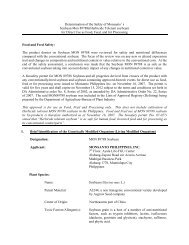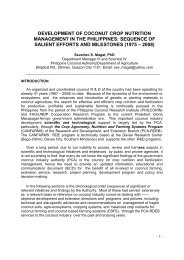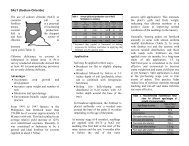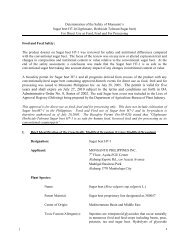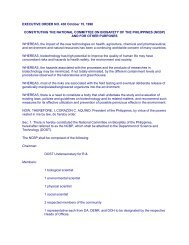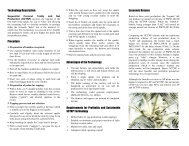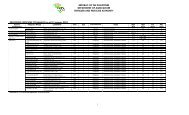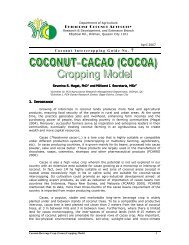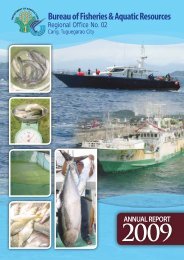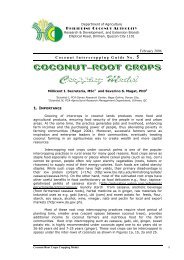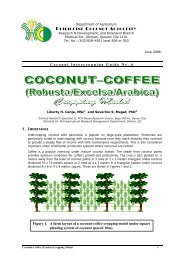Department of Agriculture - Philippine Coconut Authority
Department of Agriculture - Philippine Coconut Authority
Department of Agriculture - Philippine Coconut Authority
Create successful ePaper yourself
Turn your PDF publications into a flip-book with our unique Google optimized e-Paper software.
<strong>Department</strong> <strong>of</strong> <strong>Agriculture</strong><br />
P HILIPPINE C OCONUT A UTHORITY<br />
Research & Development, and Extension Branch<br />
Elliptical Rd., Diliman, Quezon City 1101<br />
<strong>Coconut</strong> Intercropping Guide No. 4<br />
October 2005<br />
1. IMPORTANCE<br />
Growing <strong>of</strong> intercrops in coconut lands produces more food and<br />
agricultural products, ensuring food security <strong>of</strong> the people in rural and urban<br />
areas. At the same time, the practice generates jobs and livelihood, enhancing<br />
farm incomes and the purchasing power <strong>of</strong> people, thus alleviating poverty in<br />
farming communities. Moreover, successful farmers serve as inspiration and<br />
enterprise leaders in their communities, eventually treating coconut farming in an<br />
agribusiness way to create wealth and more capital resources.<br />
Vegetable intercropping under coconut palms is one <strong>of</strong> the popular<br />
intercropping practices in rural areas for many good reasons. This intercropping<br />
practice requires short period <strong>of</strong> planting time, smaller area (vacant spaces<br />
between coconut trees), provides additional income to coconut farmers and<br />
nutritious food for the farm communities. Vegetable intercropping such as<br />
tomato, eggplant, sweet pepper, squash, okra, ginger etc. is highly recommended<br />
under coconuts aged one to six years old or 26-60 years old. These vegetables<br />
can be intercropped in plots under the interrows <strong>of</strong> coconuts as shown in Figures<br />
1 and 2.<br />
Figure 1. A farm layout <strong>of</strong> a coconut-vegetable cropping model under<br />
square planting system <strong>of</strong> coconut with spacing <strong>of</strong> 8-10 meters.<br />
<strong>Coconut</strong>-Vegetable Cropping Model 1
Figure 2. A farm layout <strong>of</strong> a coconut-vegetable cropping model under<br />
triangular planting system <strong>of</strong> coconut with spacing <strong>of</strong> 8-10 meters.<br />
2. ADVANTAGES AND BENEFITS<br />
Depending on the age or development stage <strong>of</strong> coconut, a variety <strong>of</strong><br />
vegetable crops are suitable and productive under coconut stands. Under the<br />
three growth stages (1,II, III) from field planting up to 26-60 years old, the<br />
proper vegetable intercrops had been identified as shown in Table 1.<br />
Table 1. Growth duration and productivity periods, levels <strong>of</strong> sunlight transmission<br />
and suitable intercrops (Magat, 2004).<br />
Phase<br />
(Stage)<br />
I<br />
Duration<br />
Fieldplanting<br />
6 years<br />
to<br />
Level <strong>of</strong> available sunlight/ highly suitable intercrops<br />
High to Moderate/Highly Suitable Intercrops:<br />
Cereals - corn, upland rice<br />
Legumes - cowpea, peanut, mungbean, sitao, beans<br />
Root crops - sweet potato, gabi<br />
Fruit crops - pineapple, citrus, watermelon, papaya, banana<br />
Vegetables - tomato, cabbage, eggplant, sweet pepper, hot<br />
pepper, okra<br />
II 7-25 years 1 Moderate to Low/Highly Suitable Crops:<br />
Black pepper, cacao, c<strong>of</strong>fee, tomato, vanilla, ginger, lanzones,<br />
rambutan, durian, mangosteen, gmelina tree (for wood and<br />
lumber)<br />
<strong>Coconut</strong>-Vegetable Cropping Model 2
Phase<br />
(Stage)<br />
Duration Level <strong>of</strong> available sunlight/ highly suitable intercrops<br />
III 26-60 years High/Highly Suitable Crops 2 :<br />
Cereals - corn, upland rice<br />
Legumes - peanut, mungbean, cowpea, beans<br />
Vegetables - tomato, eggplant, cabbage, sweet pepper, hot<br />
pepper, okra, ginger<br />
Root crops - sweet potato, gabi, cassava, ubi<br />
Beverage crops - c<strong>of</strong>fee, cacao<br />
Fruit crops - lanzones, rambutan, durian, mangosteen, citrus<br />
(pomelo, calamansi)<br />
Wood and Lumber tree - gmelina<br />
Fiber crops - ramie, abaca<br />
1<br />
Except tomato, usually the suitable crops indicated requires lower sunlight or moderate shade<br />
during the pre-bearing stage <strong>of</strong> the crops, thus field-establishment best done during this stage.<br />
2 Should more sunlight transmission to intercrops needed for normal growth and high yields,<br />
coconut leaf pruning (CLP) technique (removal <strong>of</strong> older lower leaves <strong>of</strong> the crown, maintaining<br />
the upper 19-23 leaves); allowing 0.5 meter <strong>of</strong> cut frond attached to the trunk.<br />
The different vegetable crops can be grouped into several families (East-West<br />
Seed Company Technology Manual), as follows:<br />
1) Solanaceae- tomato, sweet pepper, hot pepper and eggplant<br />
2) Cucurbitaceae – ampalaya, patola, cucumber, calabaza (squash),<br />
upo, watermelon, muskmelon<br />
3) Cruciferae and leafy vegetables – cabbage, cauliflower, pechay, radish,<br />
mustaza, kangkong, coriander<br />
4) Alliaceae and other crops – shallot, onion, carrot, sitao, snapbean,bush<br />
sitao, mungbean,cowpea, okra, sweet corn<br />
Some <strong>of</strong> the key benefits <strong>of</strong> the coconut-vegetable cropping/ecosystem are as<br />
follow:<br />
1) Vegetable crops can be intercropped in coconut palms as young as 1-6 years<br />
old and when these palms reached 25 years (and beyond). Generally,<br />
vegetables and coconut do not compete for soil resources, provided they are<br />
supplied with the required fertilizers needed by each crop.<br />
2) Vegetable crops can be planted anytime <strong>of</strong> the year. There is a stable and<br />
continuous demand as it is consumed daily in everyone’s dining table.<br />
3) Its nutritive value and health benefits are well-known. a) Tomato – a rich<br />
source <strong>of</strong> vitamin C; b) watermelon – low in calories, high in Vitamin C and A,<br />
in the form <strong>of</strong> disease fighting beta-carotene, high in lycopene(powerful<br />
oxidant), second to tomatoes,lycopene and beta-carotene work in conjunction<br />
with other plant chemicals not found in vitamin/ mineral supplements<br />
(http://www.urbanext.uiuc.edu/veggies/ watermelon.html) ; c) Ampalaya –<br />
rich in iron, used in the treatment <strong>of</strong> skin diseases, sterility, as an antipyretic,<br />
purgative, one <strong>of</strong> the best herbal medicines for its ability to help with liver<br />
problems and HIV(ampalaya.com) ; d) cucumber –is rich in Vitamin A, C, iron,<br />
Ca, carbohydrates and dietary fiber (http://www.urbanext.uiuc.edu/veggies/<br />
cucumber.html).<br />
4) Intercropping coconut with different kinds <strong>of</strong> suitable vegetables intensifies<br />
land use which increases returns on cash inputs and provides better labor-use<br />
pattern and income distribution.<br />
<strong>Coconut</strong>-Vegetable Cropping Model 3
5) From the coconut trees, obtained are many basic food products from nuts<br />
(like kernel/meat, coconut milk, coconut oil, coconut water/juice) and coconut<br />
sap (fresh sap, vinegar, coconut nectar/honey and natural sap sugar); nonfood<br />
raw materials for various high value products (husked- based, shellbased).<br />
Many more products are derived from other parts <strong>of</strong> the coconut<br />
trees.<br />
2. MARKET DEMAND AND PRACTICES<br />
2.1. Tomato (Lycopersicon esculentum Miller) is a seasonal fruit vegetable grown<br />
in almost all parts <strong>of</strong> the country. Although it ranks second to eggplant in terms<br />
<strong>of</strong> total production area, seasonality <strong>of</strong> production limits the domestic supply and<br />
remains a common problem <strong>of</strong> the industry (http://www.hortinet.pcarrd.dost.<br />
gov.ph/tomato industry_situationer.html). A rich source <strong>of</strong> Vitamin C, tomato is<br />
popular cash crop for small farmer-growers and home gardeners. Recognizing its<br />
vital contribution to the local economy, the DA and the DOST have identified<br />
tomato, among others, as a priority crop in their respective R&D programs.<br />
Major tomato producing regions are Northern Mindanao and Southern<br />
Tagalog. These regions collectively contributed about 60% <strong>of</strong> the total tomato<br />
production. On the other hand, the highest producing provinces in 2002 were<br />
Pangasinan, Bukidnon, Ilocos Norte, Ilocos Sur, Iloilo, Nueva Ecija and Laguna.<br />
Local tomato production fluctuated from 1990 to 2002 with the highest<br />
production volume <strong>of</strong> 183,962 MT in 1990 (http://www.hortinet.pcarrd.dost.<br />
gov.ph/tomato industry_situationer.html). The low production volumes were<br />
obtained during 1993 at 138,486 MT and 1998 at 132,984 MT. the decline in<br />
production is mainly attributed to general reduction in yield and in area planted.<br />
Furthermore, strong typhoons hit the top producing areas in Luzon in the early<br />
and mid-90’s causing considerable damage to vegetable plantations including<br />
tomato.<br />
Just like the production volume, area and yield, the country’s annual per<br />
capita consumption <strong>of</strong> tomato also had a fluctuating the 1990-2001. The highest<br />
per capita consumption obtained in 1990 at 2.33/yr while the lowest were 1.42<br />
kg/yr and in 2001 at 1.46kg/yr. On the average, around 78% <strong>of</strong> the gross supply<br />
<strong>of</strong> tomato are utilized as fresh, about 15% as processed and 7% as feed. Less<br />
than one percent is used as seeds and for export. Utilization <strong>of</strong> the various<br />
tomato products (fresh, processed, feeds)- same trend –fluctuating with a<br />
decrease in the years 1993 and 1998.<br />
The regular-client relationship known as the ‘suki’ system. The type <strong>of</strong><br />
middlemen involved are assembler-wholesalers, contract-buyers, wholesalers<br />
wholesaler-retailers and retailers.<br />
2.2 Eggplant (Solanum melongena L.) – ranked the country’s 7 th among the<br />
world’s top eggplant producers in 1999(PCARRD Eggplant Industry Situationer,<br />
2000). Eggplant is the country’s top ranking vegetable in terms <strong>of</strong> production<br />
value, about 179,000 tons per year valued at almost P2M and some 20,000 has,<br />
almost 1/3 <strong>of</strong> them in Ilocos Region (http://www.bar.gov.ph). Although it is<br />
grown in almost all parts <strong>of</strong> the country, its production is primarily for domestic<br />
market. Recognizing its vital contribution to the local economy, the Dept. <strong>of</strong><br />
<strong>Agriculture</strong> and Science (DA) & Technology (DOST) identified eggplant, among<br />
others, as a priority crop in their respective R & D program.<br />
<strong>Coconut</strong>-Vegetable Cropping Model 4
From 1990-99, area planted to eggplant increased from16,425 to 17,797<br />
ha, production increased from 112,000 t (1990) to 182,000 t (1999); yield also<br />
increased from 6.8 t/ha (1990) to 10.2 t/ha (1999). Of the total production<br />
volume in 1998, 38 t was used for seed production and 14,412t for feeds and<br />
waste. Per capita consumption in 1998 was 2.27 kg/yr, down by 9.6% from that<br />
<strong>of</strong> the previous year.<br />
Market assistance is provided by local government units. Credit assistance<br />
is availed thru the Land Bank <strong>of</strong> the <strong>Philippine</strong>s.<br />
2.3 Ampalaya (Momordica charantia) – is a vegetable grown throughout the<br />
<strong>Philippine</strong>s. It grows wild in the remote areas <strong>of</strong> Mt. Banahaw. Known in the west<br />
as Chinese bitter melon, ampalaya became popular in the news recently because<br />
<strong>of</strong> its putative medicinal value especially HIV/AID-Compound Q<br />
(http:/www.tribo.org/vegetable/ampalaya.html)<br />
2.4 Watermelon – After years <strong>of</strong> recording production cutbacks, watermelon<br />
growers posted a 35.4 % expansion in production in 2002. This was followed by<br />
another 17.1 % increase in 2003 (http://bas.gov.ph/downloads_view). Of the<br />
total watermelon production in 2003, about 77% was contributed by the top 5<br />
producing provinces in Luzon wherein Pangasinan contributed the biggest share<br />
<strong>of</strong> 36%.<br />
3. GROWING CONDITIONS AND THE TECHNOLOGY<br />
3.2 Environmental Requirements<br />
To optimize the achievable yield <strong>of</strong> vegetables under the coconutvegetable<br />
cropping system, it is essential to provide the suitable conditions<br />
(climate and soils) for the two crops. Moreover, the competition for light, soil and<br />
water resources usually results in marginal economic returns from one <strong>of</strong> the<br />
component crops or in both.<br />
A. <strong>Coconut</strong><br />
Climatic Needs:<br />
Factor<br />
Altitude (m above sea level Less than 600<br />
Temperature ( o C) 24- 29<br />
Light<br />
Total annual rainfall (mm)<br />
Typhoon frequency (%) < 20<br />
<strong>Coconut</strong><br />
>2000 sunshine hours/year<br />
1500- 2500 (well distributed)<br />
Soil Requirements:<br />
Soil Condition<br />
<strong>Coconut</strong><br />
Soil Depth (cm) >75<br />
Drainage<br />
Moderate to well-drained<br />
Soil Acidity (pH) 5.5-7.5<br />
Soil Texture<br />
Sandy, loamy, clayey (with good structure)<br />
Organic matter content<br />
Medium to High<br />
Major nutrients<br />
N, K, Cl, S, P, Ca, Mg, B<br />
<strong>Coconut</strong>-Vegetable Cropping Model 5
B. Vegetables<br />
B.1 Tomato – requires a relatively cool, dry climate fro high yield and premium<br />
quality and is adapted to a wide range <strong>of</strong> climatic conditions<br />
(http://www.hortinet. pcarrd.dost.gov.ph/tomatoindustry_situationer.html.<br />
The optimum temperature requirement is 21-24 0 C. It can be grown in<br />
varied soil types as sandy loam to clay-loam with rich organic matter. It<br />
should not be planted in areas with long period <strong>of</strong> flooding. The ideal pH is<br />
6.0-6.5. It can be harvest in 90-100 days after transplanting during the cool<br />
season and 60-90 days after transplanting during hot season.<br />
B.2 Eggplant – requires a relatively cool, dry climate for optimum yield and<br />
quality, grown year-round ((PCARRD Eggplant Industry Situationer, 2000).<br />
In the lowlands <strong>of</strong> Batangas, eggplant is planted in November and harvested<br />
from Feb. to March, in Cebu planting season starts in April, while harvesting<br />
season starts from June to August.<br />
B.3 Ampalaya grows well in tropical and subtropical climates. It grows well in<br />
all types <strong>of</strong> soil provided it is well drained. The best type <strong>of</strong> soil texture is a<br />
sandy loam, rich in organic matter. The optimum soil temperature for<br />
germination is 30-35 0 C (Ampalaya pamphlet, Allied Botanical Corp.).<br />
B.4 Sweet pepper (Capsicum annuum L.) requires cool weather for best<br />
quality, in low elevations, however, planting is best from October to<br />
December (http://www.da.gov.ph/tips/sweet pepper.html) It mid and high<br />
elevations it can be grown throughout the year. It grows well in any type <strong>of</strong><br />
soil with pH <strong>of</strong> 5.5 to 6.5. Production is best in deep loam soil with good<br />
fertility, easy irrigation, adequate drainage and plenty <strong>of</strong> sunshine. It<br />
germinates well at temperature <strong>of</strong><br />
20-30 0 C and grows best at around 25 0 C. It should not be grown on the<br />
same soil year after year because <strong>of</strong> disease problems. It is best to rotate<br />
the crop with rice, legume, sugarcane and corn.<br />
B.5 Cucumber – is a tender, warm season vegetable that produces well when<br />
given proper care and protection. Having shallow roots, it requires ample<br />
soil moisture at all stages <strong>of</strong> growth.<br />
B.6 Watermelon – requires warm, relatively dry climate and plenty <strong>of</strong> sunshine<br />
fro rapid growth and development. It performs well when grown in well<br />
drained and sandy loam soil preferably rich in organic matter, although yield<br />
on clay soils can be increased significantly by mulching raised planting rows<br />
with black plastic film. Ideal soil should have ph <strong>of</strong> 6-7 (Watermelon<br />
Pamphlet, Allied Botanical Corporation).<br />
4.2 Technology<br />
It is very important to apply the best package <strong>of</strong> technologies (POT) or<br />
better still, the site-specific technologies to achieve the maximum economic yield<br />
(MEY), highly desirable to obtain the least production cost per unit product or per<br />
ha, and the maximum returns to investment under the coconut-vegetable<br />
cropping production system.<br />
4.2.1 Vegetables<br />
1) Land preparation – Clear/underbrush interspaces under coconut trees and<br />
remove all stumps, plow and harrow twice or thrice to remove weeds.<br />
<strong>Coconut</strong>-Vegetable Cropping Model 6
4.2.1.1 Solanaceous crops (Tomato, Eggplant, Sweet Pepper)<br />
1) Nursery preparation– prepare seedbeds measuring 1 m x 5 m, sterilized soil<br />
by any <strong>of</strong> the following methods: a)burn straw over the seedbed b) pour<br />
boiling water into the seedbed c) bake soil and place in seed boxes d) drill the<br />
seeds and cover lightly with soil d) water daily during dry period until ready<br />
for transplanting (PCA Intercropping Guide).<br />
2) Plot preparation – prepare furrows 75 cm apart, 2.0 meters from the coconut<br />
trees<br />
3) Transplanting – water the seedbed thoroughly to loosen the soil, pull carefully<br />
the seedlings to avoid injury, transplant seedlings in prepared furrows,<br />
preferably in the afternoon.<br />
4) Distance <strong>of</strong> planting – tomato -0.75 m between hills, straight planting<br />
eggplant – 0.50 m between hills, zigzag planting<br />
sweet pepper – 0.75 m between hills, straight planting<br />
5) Select any <strong>of</strong> the following recommended varieties: (see East-West Seed Co.<br />
Inc. Technology Manual for description <strong>of</strong> each variety and technical<br />
information <strong>of</strong> different vegetable crops (Annex A)<br />
a) Tomato – Diamante F1, Marimar F1, Maxima F, Improved Pope, Cardinal<br />
b) Eggplant – Domino F1, Casino F1, jackpot F1, Bulakena, Batangas Long<br />
Purple<br />
c) Sweet pepper – Majesty F1, Bless F1, All Season, Trinity F1<br />
d) Hot pepper – Django F1, Sinigang, Hotshot<br />
6) Maintenance – Off-bar two weeks after transplanting, apply fertilizer at<br />
different growth stages (see Annex B), hill-up after fertilization, remove<br />
weeds.<br />
7) Harvesting<br />
a) Tomato – harvest as 1) mature green fruit starts to show cream streaks at<br />
the bottom end; 2) breaker-blossom end turns pinkish or reddish; 3) red<br />
ripe – full red skin color is attained.<br />
b) Eggplant – harvest when fruit reaches 2/3 <strong>of</strong> its maximum size for the<br />
variety before fruit hardens or shows streaks <strong>of</strong> unusual color<br />
c) Pepper – harvest as 1) mature green(fruit waxy and shiny); 2) breaker<br />
(fruit turns yellow or reddish); 3) red ripe (fruit skin is red)<br />
4.2.1.2 Cucurbitae Crops (Ampalaya, patola, cucumber, calabaza, upo,<br />
watermelon, muskmelon)<br />
Ampalaya and Cucumber<br />
1) Distance <strong>of</strong> planting<br />
a) Ampalaya – 1 m between hills x 2 rows distance at 3 m apart in between 2<br />
rows <strong>of</strong> coconut trees, straight planting<br />
b) Cucumber – 0.50 m between hills x 3 rows at 1 m apart in between 2 rows<br />
<strong>of</strong> coconut trees<br />
<strong>Coconut</strong>-Vegetable Cropping Model 7
2) Recommended varieties<br />
a) Ampalaya – Galaxy F1, Jade Star L F1, Jade Star XL F1, Sta. Rita EW<br />
Select,<br />
b) Cucumber - Ambassador F1, Governor F1, Champ F1, Green Beret F1,<br />
Jackson<br />
27 F1, Poinsett<br />
c) Patola – Hercules F1, Esmeralda<br />
d) Upo – Dalisay F1, Tambuli, Maxi<br />
3) Method <strong>of</strong> planting – direct seeding is recommended for these vegetable crops<br />
(plant 1 seed per hill at 1-2 cm deep and thin the seedling to one plant)<br />
4) Irrigation – irrigate the plants whenever necessary. Furrow irrigation or hand<br />
water up to field capacity at 7-10 days interval. Be careful not to water-log<br />
the soil since ampalaya is sensitive to poor drainage.<br />
5) Trellising – ampalaya is always trellised especially during wet months. Vertical<br />
trellises are constructed using ipil-ipil or bamboo poles (6 ft ht) and tied with<br />
wire, abaca or twines. Overhead trellis is also needed. Trellises must be done<br />
as soon as possible, but not later than the “one meter vine” length stage. As<br />
vine develops, train them to cling to the trellis.<br />
6) Weeding – is necessary especially around the base <strong>of</strong> the plants within the<br />
rows. Hilling up is also necessary as the vines start to climb the trellis.<br />
Remove the weeds in between rows and whenever they start to grow.<br />
Harvesting –<br />
a) Ampalaya –usually takes 15-20 days after fruit set to reach a<br />
marketable stage. Fruits are best harvested by cutting fruit peduncle<br />
with scissors or sharp knife.<br />
b) Cucumber –pick cucumbers at any stage <strong>of</strong> development before seeds<br />
become hard. Cucumbers usually are eaten when immature. The best<br />
size depends upon the use and variety. They maybe when they have<br />
no more than 2 inches long for pickles, 4-6 inches long for dills and 6-8<br />
inches long for slicing varieties (http://www.urbsnext.uiuc.edu/<br />
veggies/cucumber1.html).<br />
Watermelon<br />
1. Planting distance - 1 m between hills x 3 m between rows<br />
2. Recommended varieties: Sweet Senorita F1, Sweet Ruby F1, Sweet Sixteen<br />
F1, Sugar baby, Sakata Goody ball F1, Sakata Sugar Baby OP, Condor Sugar<br />
baby OP, Thunderball F1, TK Hunter F1, Unicorn F1, KSU-003 F1<br />
3. Method <strong>of</strong> planting – plant one seed at 2 cm depth, use plastic mulch to<br />
promote earliness in flowering by warming the soil beneath the plastic.<br />
Planting <strong>of</strong> watermelon is recommended under open field (not under<br />
coconut trees) due to its high light requirement. However, it can still<br />
be planted in coconut plantation in single row planting with in-row<br />
spacing <strong>of</strong> 5m and between row spacing <strong>of</strong> 10 m (Magat, 2003). This<br />
kind <strong>of</strong> coconut planting provides 100% more palms (100 palms) than square<br />
10m x 10 m planting system and direct sunlight transmission to coconut<br />
interrows due to wider planting distance.<br />
4. Irrigation and drainage – watermelon is a thirsty plant. Provide adequate<br />
water throughout the early growing season for good plant growth. When the<br />
<strong>Coconut</strong>-Vegetable Cropping Model 8
female flowers appear regulate water supply to improve fruit setting. Then<br />
add more water when the fruit starts to develop. However, during ripening<br />
stage, it is important to reduce or withhold water for better tasting and<br />
sweeter fruits (Watermelon pamphlet, Allied Botanical Corp.).<br />
5. First fruiting – usually the first flowers produce poorly developed ovaries<br />
which results in deformed fruits. Removal <strong>of</strong> the first fruits is usually<br />
recommended (Watermelon pamphlet, Allied Botanical Corp.). Leave only 2-3<br />
healthy fruits per plant. Most <strong>of</strong> the flowers appears 30-50 days after<br />
emergence.<br />
6. Weed control – is essential especially during early stage. However,<br />
watermelon is sensitive to some herbicide and should be applied with care. It<br />
is advisable to practice mulching (plastic or rice straw).<br />
7. Harvesting – at 30-50 days after pollination. Use a combination <strong>of</strong> the<br />
harvesting indicators: 1) light green, curly tendrils on the stem near the point<br />
<strong>of</strong> attachment <strong>of</strong> the melon usually turn brown and dry; 2) the surface color<br />
<strong>of</strong> the fruit turns dull; 3) the skin becomes resistant to penetration by the<br />
thumbnail and is rough to the tough; 4) the bottom <strong>of</strong> the melon (where it lies<br />
on the soil) turns from light green to a yellowish color<br />
(http://www.urbanext.uiuc.edu/veggies/watermelon1.html).These indicators<br />
for choosing a ripe watermelon are much reliable than “thumping” the melon<br />
with a knuckle. Many watermelon do not emit the proverbial “dull” thud when<br />
ripe. For these, the dull thud may indicate an over-ripe, mushy melon.<br />
The growing vegetable industry is enhanced with the promotion <strong>of</strong> R & D<br />
works <strong>of</strong> government, non-government agencies and private seed companies<br />
that have developed several modern vegetable technologies to increase<br />
vegetable productivity. These are the vegetable farming practices using:<br />
a) Plastic mulch – to secure vegetable production during rainy season and<br />
reduce time and labor cost for weeding, plastic mulch is being used by<br />
vegetable planters today (EWSC leaflet). The plastic mulch can be used in<br />
planting solanaceous vegetables and fruit vegetable i.e. watermelon<br />
planting (Fig.1a). To clip the plastic mulch firmly on the soil, cutted<br />
coconut leaf fronds about 6 inches in length with pointed tip was used<br />
instead <strong>of</strong> bamboo sticks (commonly used). Placing holes in the plastic<br />
mulch was done by pre-heating an appropriate size <strong>of</strong> tin can and pressing<br />
it into designated planting hole (Fig.1b). The benefits <strong>of</strong> plastic mulch are<br />
the following (ESWC New Technologies Info Package):<br />
a. Reduces evaporation –soil water loss is reduced under plastic mulch.<br />
As a result, a more uniform soil moisture is maintained and irrigation<br />
frequency can be reduced.<br />
b. Fewer weed problems – black & silver-on-black mulches reduce light<br />
penetration to the soil. Weeds cannot generally survive under such a<br />
condition.<br />
c. Reduces fertilizer leaching – excess water run-<strong>of</strong>f the impervious<br />
mulch, fertilizer beneath the mulch is not lost by leaching so that<br />
fertilizers are optimally used and not wasted.<br />
d. Reduces soil compaction –soil under plastic mulch remain loose, friable<br />
and well-aerated.<br />
e. Root pruning eliminated – cultivation is eliminated except in the area<br />
between the mulched strips.<br />
<strong>Coconut</strong>-Vegetable Cropping Model 9
f. Cleaner vegetable produce – edible product from mulched crop is<br />
cleaner and less subjected to rot, since no soil is splashed onto the<br />
plants or fruit.<br />
g. Reduce drowning <strong>of</strong> crops – water is shed from the row area by the<br />
raised tapered bed so that excess runs <strong>of</strong>f the field, thus reducing<br />
drowning and other excess soil water stress.<br />
b) Trellis/Trellising net – is most commonly used in growing cucurbits like<br />
ampalaya, upo, patola, melon and cucumber. It is also being used in<br />
legumes and some other solanaceous crops. This was used in ampalaya,<br />
tomato and cucumber production at PCA-DRC (Fig .2). The advantages <strong>of</strong><br />
trellis/trellising nets are:<br />
a. Helps you save on space<br />
b. Plants are easier to care for<br />
c. Plants will not be easily destroyed by heavy rains or winds<br />
d. Fruits are not easily attacked by ground crawling pests<br />
e. Fruits are healthier and cleaner<br />
f. Fruits are less subjected to rot than when lying on the soggy soil<br />
c) Seedling tray (Fig. 3a) - for tomato and eggplant seedlings for good and<br />
vigorous seedling is important, even critical because the health or quality<br />
<strong>of</strong> seedlings will largely contribute and determine the success <strong>of</strong> the crop.<br />
In the absence <strong>of</strong> plastic trays, seedlings can be temporary transplanted in<br />
native seedling container - rolled banana leaves (Fig. 3b) about one week<br />
before field planting.<br />
d) Yellow sticky (with grease) billboard in vegetable plots as insect repellant<br />
– to minimize insect infestation and use <strong>of</strong> synthetic insecticides, these<br />
materials are being installed in the vegetable demo plots at PCA-DRC,<br />
Bago Oshiro, Davao City as illustrated in Figure 4.<br />
e) Foliar fertilization – if the supply <strong>of</strong> one or more <strong>of</strong> major (N, P, K)<br />
secondary (Ca, Mg, S) and trace nutrients (Fe, Mn, Mo, B, Cu, Zn, Cl and<br />
Ni) is deficient, plant’s growth and development will be adversely affecting<br />
its yields (Yara Fertilizer Phil. Leaflet). To get high yield, these plant food<br />
nutrients must be present in the soil in available forms and in sufficient<br />
and balanced amounts. This is an ideal situation and hardly achievable.<br />
Soil application <strong>of</strong> fertilizers is still major method to feed effectively.<br />
However, there are some instances where nutrients from the soil becomes<br />
hardly available to plants.<br />
Thus, the need for foliar fertilization <strong>of</strong>fers a simple solution to<br />
tackle nutrient deficiency problems. It is a good and practical to<br />
supplement the soil-applied fertilizer (Yara Fertilizer Phil. Leaflet). Some <strong>of</strong><br />
the benefits <strong>of</strong> foliar fertilization are as follows:<br />
1) Quick plant response to treating physiological disorders in plant caused<br />
by nutrient deficiency/depletion in the soil;<br />
2) Effective in alleviating temporary nutrient deficiencies due to the<br />
absence <strong>of</strong> non-conducive soil environment; and<br />
3) Two to twenty (2-20) times more efficient in food translocation than<br />
soil-applied fertilizers.<br />
Some <strong>of</strong> the important nutrients for vegetables that can be applied in<br />
liquid form are: (based on Liquid Natural Organic Micronutrient Chelates<br />
Leaflets and Liquid Systemic Nutrient ([P] Delivery Leaflet, Sagrex Corp)<br />
<strong>Coconut</strong>-Vegetable Cropping Model 10
Nutrient Function Deficiency Symptoms<br />
Rate/Mode<br />
<strong>of</strong> Application<br />
1) Boron- B (10%)<br />
– highly needed<br />
by ampalaya,<br />
watermelon<br />
Protein synthesis,<br />
formation <strong>of</strong> plant<br />
hormones, promotes<br />
maturity, increases<br />
set <strong>of</strong> flowers by<br />
enhancing<br />
femaleness and<br />
inhibiting maleness,<br />
affects nitrogen &<br />
carbohydrates,<br />
water relation in<br />
plants<br />
Death <strong>of</strong> apical<br />
growing point, lateral<br />
shoots then develop &<br />
their growing points<br />
die so that plant<br />
becomes stunted &<br />
composed<br />
<strong>of</strong><br />
numerous small<br />
shoots, stems &<br />
leaves may become<br />
thickened, distorted,<br />
brittle, flowering &<br />
fruiting greatly<br />
reduced.<br />
Deficiency Rate<br />
Crop Maint. 1 li/ha<br />
Mod. Def. 2-3li/ha<br />
Sev.Def 3-4 li/ha<br />
Frequency <strong>of</strong> appln-<br />
Spray every 15 days,<br />
applied after heavy<br />
rain or irrigation,<br />
early morning or late<br />
afternoon<br />
2) Zinc - Zn (10%)<br />
Micronutrient<br />
chelates<br />
Growth hormone,<br />
seed & grain<br />
formation, maturity<br />
date, height <strong>of</strong><br />
plant, protein<br />
synthesis<br />
Death <strong>of</strong> apical<br />
growing point, uneven<br />
maturity <strong>of</strong> seeds<br />
Crop Maint. 1-2 li/ha<br />
Med.Def. 2-3 li/ha<br />
Sev. Def. 3-4li/ha<br />
3) Copper – Cu<br />
(5%)<br />
Enzyme activator,<br />
major function in<br />
photosynthesis & in<br />
reproductive stages,<br />
respiration,<br />
increases sugar<br />
content, improves<br />
flavor, intensifies<br />
color and greatly<br />
improves the<br />
keeping qualities in<br />
fruits &vegetables in<br />
shipment & storage.<br />
Inhibit conversion <strong>of</strong><br />
ammonia to glutamic<br />
acid (protein) and a<br />
tip burn and marginal<br />
scorch seen on the<br />
leaves, leaves may<br />
appear twisted &<br />
curled.<br />
Crop Maint. 1-2li/ha<br />
Mod. Def. 2-3 li/ha<br />
Sev.Def. 4-6li/ha<br />
4) Molybdenum –<br />
Mo (4%)<br />
N metabolism & is<br />
necessary for the<br />
fixation <strong>of</strong> nitrogen<br />
by N-fixing bacteria,<br />
essential for nitrate<br />
reduction<br />
Chlorosis in the form<br />
<strong>of</strong> spotting, mottling<br />
or general yellowing<br />
Crop Maint. 2li/ha<br />
Mod. Def. 1-2li/ha<br />
Sev. Def. 3-4 li/ha<br />
Applied at early<br />
growth phase until<br />
before plts enter their<br />
max. growth basic to<br />
legumes, esp. if no<br />
seed inoculation is<br />
practiced.<br />
<strong>Coconut</strong>-Vegetable Cropping Model 11
Nutrient Function Deficiency Symptoms<br />
Rate/Mode<br />
<strong>of</strong> Application<br />
5. Calcium - Ca<br />
(chelated) –<br />
12%<br />
Strengthens cell<br />
walls<br />
and<br />
membranes, ensures<br />
vigorous healthy<br />
growth, disease<br />
resistance &<br />
protection from<br />
toxins, longer shelf<br />
life, keeps freshness<br />
<strong>of</strong> harvested fruit or<br />
crop to avoid losses<br />
from wilting/rotting<br />
during storage or<br />
transport; Adequate<br />
Ca and correct Ca-<br />
Mg ratio contributes<br />
to good soil<br />
structure & texture<br />
hence water<br />
penetration &<br />
aeration.<br />
Poor soil structure,<br />
hence poor aeration<br />
resulting to an<br />
anaerobic decomposition<br />
process <strong>of</strong> crop<br />
residues that produces<br />
alcohol& formaldehyde<br />
instead <strong>of</strong> mild acids<br />
that forms humus<br />
complex. Alcohol<br />
(microbicide) kills<br />
microbes<br />
and<br />
formaldehyde – a<br />
preservative for<br />
embalming when<br />
present in the soil are<br />
detrimental to the<br />
crops.<br />
Incidence <strong>of</strong> diseases<br />
e.g.burning <strong>of</strong> leafy<br />
vegetables’ tips &<br />
edges (cabbage &<br />
lettuce), blossom end<br />
<strong>of</strong> tomato, potato s<strong>of</strong>t<br />
rot, “water drenched’<br />
marks in watermelon<br />
Crop Maint. 1-2 li/ha<br />
Med.Def. 2-3 li/ha<br />
Sev. Def. 3-4li/ha<br />
6. Phosphorus<br />
(Phos Pro) 16%<br />
P w/ 4% Ca<br />
Increased fruit set,<br />
more uniform<br />
maturity, improved<br />
yield-solids content<br />
<strong>of</strong> fruit &<br />
vegetables,improves<br />
handling, storage<br />
and keeping<br />
qualities <strong>of</strong> crops,<br />
require for normal<br />
root development <strong>of</strong><br />
plants<br />
Plants susceptible to<br />
fungal and bacterial<br />
plant pathogens, less<br />
uniform maturity <strong>of</strong><br />
crops, low quality <strong>of</strong><br />
crops in terms <strong>of</strong> its<br />
storage ability<br />
Crop Maint. 1-2 li/ha<br />
Med.Def. 2-3 li/ha<br />
Sev. Def. 3-4li/ha<br />
7. Manganese Mn<br />
(5%)<br />
Have a direct or<br />
indirect influence on<br />
chlorophyll<br />
formation, enzymes<br />
that function in<br />
respiration, &<br />
protein synthesis,<br />
activates the<br />
reduction <strong>of</strong> nitrate<br />
& hydroxylamine to<br />
ammonia.<br />
Chlorosis as flecking,<br />
streaking or mottling<br />
depending on the<br />
crop affected. Growth<br />
is stunted, necrotic<br />
areas may develop on<br />
the leaves, subnormal<br />
root development,<br />
yellowish-green stem<br />
<strong>of</strong>ten hardy & woody<br />
Crop Maint. 2 li/ha<br />
Med.Def. 4-5 li/ha<br />
Sev. Def. 6-8li/ha<br />
Liquid Mn –<br />
recommended to be<br />
used during the entire<br />
growth <strong>of</strong> plant.<br />
<strong>Coconut</strong>-Vegetable Cropping Model 12
f. Pest and disease management on vegetables<br />
Pest and disease incidence on vegetables if not controlled can also affect<br />
greatly the yield <strong>of</strong> these crops. Hence, proper and timely application <strong>of</strong><br />
preventive measure should be done. A knowledge <strong>of</strong> the possible pest and<br />
disease incidence for different kinds <strong>of</strong> crops is therefore necessary.<br />
Some <strong>of</strong> the most common pests and diseases <strong>of</strong> some vegetables and<br />
their control measures are:<br />
Pest/Disease Description Damage Control Measures<br />
Plants being<br />
attacked<br />
Pest<br />
1.Fruit worm<br />
Adult-yellowish<br />
brown, larva is<br />
pale with black<br />
head, usually<br />
wider than<br />
segments later<br />
color turn greenish<br />
brown<br />
Larva feeds on<br />
inflorescence &<br />
bores into the<br />
fruit<br />
Spray S3vin 85<br />
WP at 3tbsp/5<br />
gal <strong>of</strong> water or<br />
any insecticide at<br />
7-10 days<br />
interval until<br />
controlled, hot<br />
pepper spray, B.<br />
thuringensis<br />
Tomato,<br />
eggplant,<br />
beans,<br />
peas,potato<br />
2.Flea beetle<br />
Larva lives in the<br />
tissue <strong>of</strong> the<br />
midrib, petiole &<br />
stem. Adult is<br />
minute metallic<br />
blue<br />
Feeds on<br />
leaves &<br />
flowers <strong>of</strong><br />
vegetable,<br />
scarred stem &<br />
fruit surfaces<br />
- do -<br />
Eggplant,<br />
Cucumber,<br />
squash,<br />
cabbage<br />
3.Spider mites<br />
Nymph-yellowish<br />
to lateral brown<br />
spots,adult female<br />
is light reddish<br />
brown with dark<br />
lateral spots male<br />
adult is yellowish<br />
Nymph & adult<br />
suck the plant<br />
sap which<br />
causes leaves<br />
to discolor<br />
Spray Aramite at<br />
1kg/200 gal<br />
water<br />
Beans, onions,<br />
garlic, tomato,<br />
eggplant<br />
4. Aphids<br />
Winged & nonwinged<br />
types, form<br />
colonies underside<br />
<strong>of</strong> leaves<br />
Sucks the juice<br />
from plants &<br />
some transmit<br />
viral disease to<br />
plants<br />
Spray insecticide<br />
following<br />
recommended<br />
dosage, hot<br />
pepper soln,<br />
organophosphate<br />
Almost all<br />
Vegetables<br />
5. Fruit & shoot<br />
borer<br />
(Leucinodes<br />
orbonalis<br />
Guenee)<br />
A typical moth<br />
belonging to family<br />
Pyralidae, adult<br />
are weak fliers,<br />
active at night<br />
Larva bores<br />
into tender<br />
shoots & fruits,<br />
shoot wilt<br />
reducing plant<br />
vigor& fruit<br />
unfit for human<br />
consumption<br />
Sanitation, hot<br />
pepper spray,<br />
synthetic<br />
pyrethroids<br />
Eggplant,<br />
tomato, string<br />
beans/peas,<br />
<strong>Coconut</strong>-Vegetable Cropping Model 13
Pest/Disease Description Damage Control Measures<br />
Plants being<br />
attacked<br />
6. Thrips<br />
Very small (1.3<br />
mm)long, slender<br />
insects, with 2 prs<br />
<strong>of</strong> wings that are<br />
fringed with long<br />
hairs, adult –pale<br />
yellow light brown<br />
Feed by<br />
rasping the<br />
surface <strong>of</strong><br />
leaves &<br />
sucking up the<br />
liberated plant<br />
fluid<br />
Biological control<br />
using predaceous<br />
mites, bugs,<br />
lacewings<br />
feeding the<br />
thrips<br />
Onions, garlic<br />
tomato,<br />
pea, eggplant,<br />
Watermelon,<br />
beans<br />
Diseases<br />
1. Bacterial wilt<br />
Caused by:<br />
Erwinia<br />
tracheiphila<br />
Wilting <strong>of</strong><br />
younger leaves<br />
& yellowing <strong>of</strong><br />
the oldest leaf<br />
Remove infected<br />
plants<br />
Potato,tomato,<br />
eggplant,string<br />
beans,cucumber,<br />
2. Angular leaf<br />
spot<br />
Pseudomonas<br />
syringae<br />
Cercospora sp.<br />
Younger leaves<br />
show pale<br />
green pimples<br />
on the under<br />
surface while<br />
the upper<br />
surface<br />
develops<br />
lesions<br />
Practice crop<br />
rotation, spray<br />
dithane M-45 10-<br />
12 days when<br />
fruits are<br />
formed,sanitation<br />
Watermelon,<br />
ampalaya<br />
Tomato,<br />
beans,waterme<br />
lon, cucumber,<br />
squash<br />
ampalaya<br />
3. Downy mildew<br />
Psuedoperonospora<br />
cubensis<br />
fungus<br />
Upper leaf<br />
surfaces show<br />
angular spots &<br />
becomes<br />
necrotic as dis.<br />
progress<br />
Apply protectant<br />
and systemic<br />
fungicides<br />
Cucurbits,<br />
tomato,<br />
ampalaya<br />
4. Mosaic virus<br />
Cucumber mosaic<br />
virus(transmitted<br />
by aphids vector or<br />
mechanical<br />
means)<br />
Light & dark<br />
green molting<br />
<strong>of</strong> leaves,<br />
slight curling,<br />
malformation<br />
<strong>of</strong> leaflets<br />
Remove infected<br />
plant,<br />
sanitation,refrain<br />
from smoking,<br />
rouging<br />
Tomato,<br />
pepper,<br />
cucumber,<br />
melons,<br />
squash, celery<br />
5. Anthracnose<br />
Colletotrichum<br />
lagenarium<br />
Leaf<br />
lesions begin<br />
as water<br />
soaked, then<br />
become<br />
yellowish<br />
circular spots,<br />
black & sunken<br />
cankers appear<br />
on the fruits<br />
Practice<br />
sanitation, crop<br />
rotation, use<br />
commercially<br />
disease-free<br />
seed<br />
Cucurbits,bean<br />
<strong>Coconut</strong>-Vegetable Cropping Model 14
Pest/Disease Description Damage Control Measures<br />
Plants being<br />
attacked<br />
6. Phythopthora<br />
disease or fruit<br />
rot<br />
Phythopthora<br />
Palvimora<br />
P.capsici-pepper<br />
Infected fruit<br />
turns brown &<br />
rots in few<br />
days<br />
Crop rotation,<br />
avoid poorly<br />
drained soils,<br />
spray fungicide<br />
Cucurbits,<br />
pepper,<br />
tomato,<br />
eggplant<br />
7. Root knot<br />
nematode<br />
Meloidogyne spp.<br />
Presence <strong>of</strong><br />
swelling or<br />
knots on the<br />
roots,<br />
vegetative<br />
symptoms<br />
resemble<br />
drought injury<br />
or nutrient def.<br />
Affected plants<br />
stunted<br />
Apply<br />
manure,<br />
rotation<br />
chicken<br />
crop<br />
Cabbage,<br />
tomato,<br />
Squash,<br />
eggplant<br />
8. Early blight<br />
Alternaria<br />
fungus<br />
solani<br />
Circular brown<br />
spots appear<br />
on leaves &<br />
stems, as<br />
these enlarge,<br />
concentric<br />
rings appear<br />
giving areas a<br />
target-like<br />
appearance,<br />
defoliation <strong>of</strong><br />
lower leaves &<br />
death <strong>of</strong> plant<br />
Thinning <strong>of</strong><br />
affected plants,<br />
spray fungicide,<br />
crop rotation,<br />
use blight<br />
resistant variet.,<br />
increase spacing<br />
between plts., do<br />
not overmulch as<br />
this leads to wet<br />
soils<br />
Watermelon,<br />
tomato,<br />
eggplant,<br />
pepper,<br />
potatoes<br />
8. Late blight<br />
Phytopthora<br />
infestans<br />
Attacks both<br />
tubers and<br />
foliage at any<br />
stage <strong>of</strong> dev’t.,<br />
s<strong>of</strong>t rot <strong>of</strong><br />
tubers<br />
-do-<br />
Potato,<br />
watermelon,<br />
tomato,<br />
eggplant<br />
<strong>Coconut</strong>-Vegetable Cropping Model 15
COCONUT<br />
With the coconut trees are already established and already at bearing<br />
stage, the main farming practices are fertilization, underbrushing-weeding,<br />
mulching <strong>of</strong> the main rootzone <strong>of</strong> coconut (also considered the fertilizing zone at<br />
trunk base <strong>of</strong> trees), and harvesting. Post-harvest and primary processing<br />
practices (seasoning <strong>of</strong> partially immature nuts for 7–10 days, dehusking and<br />
copra processing) are common in small to medium scale farms. If sold to coconut<br />
desiccating plants, dehusked nuts are immediately marketed. <strong>Coconut</strong> husks<br />
await decortication/defibering, while coconut shells are converted to charcoal and<br />
sold to activated carbon processors.<br />
A separate fertilization for the stands <strong>of</strong> coconut and the vegetable crop<br />
(Annex A) is recommended. There are two average inorganic/mineral fertilizer<br />
recommendations for coconut: 1) using the combination <strong>of</strong> single fertilizers<br />
(ammonium sulfate plus common salt (for potassium-rich soils) or potassium<br />
chloride (0-0-60) for soils deficient in K; and 2) using ready-to-apply<br />
multinutrient fertilizers as the 14-5-20-0.02 (B), now commercially available like<br />
COCOGRO (ATLAS Brand) in 25 kg. capacity bags.<br />
These two fertilizer recommendations are compatible with the application<br />
<strong>of</strong> appropriate organic fertilizers (compost, cocopeat, commercial organic<br />
fertilizers). If capital resources to purchase organic fertilizers is available, any<br />
<strong>of</strong> these organic fertilizers ( total N, P and K <strong>of</strong> at least 5%) may be applied<br />
together with the mineral fertilizers (options 1 and 2) indicated below at the rate<br />
<strong>of</strong> 3-4 times <strong>of</strong> the periodic rates indicated. Organic fertilizers should be applied<br />
about a month ahead <strong>of</strong> the application <strong>of</strong> the inorganic/mineral fertilizers.<br />
Organic fertilizers serve best as soil conditioners and fertilizer supplements to the<br />
coconut-vegetable cropping system.<br />
Option 1<br />
Application <strong>of</strong> Single-Fertilizers (per tree):<br />
Age/Stage<br />
Rate <strong>of</strong> Fertilizer Combination a<br />
Field-planting (FP)<br />
150 g AS + 160 g SC or 200g KCl<br />
6 months from FP 200 g AS + 200 g SC or 200 g KCl<br />
1 year 500 g AS + 450 g SC or 600 g KCl<br />
2 years 750 g AS + 750 g SC or 900 g KCl<br />
3 years 1.0 kg AS + 1.25 kg SC or 1.5 kg KCl<br />
4 years 1.25 kg AS + 1.35 kg SC or 1.70 kg KCl<br />
5 years and onwards 1.50 kg AS + 1.70 kg SC or 2.00 kg KCl<br />
a AS – Ammonium sulfate (21-0-0);<br />
SC – Sodium chloride (common salt);<br />
KCl – Potassium chloride (0-0-60)<br />
<strong>Coconut</strong>-Vegetable Cropping Model 16
Option 2<br />
Application <strong>of</strong> ready-to-apply multinutrient<br />
fertilizer (per tree):<br />
Age/Stage<br />
Field-planting (FP)<br />
Rate <strong>of</strong> 14-5-20<br />
multi-nutrient Fertilizer a<br />
400 g<br />
6 months from FP 600 g<br />
1 year 1.25 kg<br />
2 years 1.50 kg<br />
3 years 2.00 kg<br />
4 years 2.50 kg<br />
5 years and onwards 3.00 kg<br />
a contains 14% N, 5% P2O5, 20% K2O plus 15% Cl , 4.5%S, 0.02% Boron, Ca.<br />
5. INVESTMENT NEEDS: COSTS AND RETURNS<br />
For one hectare <strong>of</strong> coconut land or in a pure stand <strong>of</strong> coconut, only about<br />
25% <strong>of</strong> the soil mass is actually utilized by the coconut (Magat,1999). The<br />
remaining 75% <strong>of</strong> coconut land can be productively utilized by planting suitable<br />
intercrops e.g. vegetables. Thus, if the effective land use index (ELUI) is<br />
assumed at: 0.30 ha for eggplant, 0.30 ha for ampalaya, 0.15 ha for cabbage,<br />
the total land use index adds to 1.75 ha or 75% increase in land use intensity<br />
(LUI) over 1 ha coconut monocropped. Hence, in the annual cropping cost and<br />
return analysis <strong>of</strong> coconut + vegetable cropping model, the ELUI for each<br />
intercrop planted with the standing coconuts is used.<br />
Table 5.1 and 5.2 shows an average cost and return analysis <strong>of</strong> the each<br />
vegetable intercrop, eggplant, ampalaya and cabbage respectively, covering a 3-<br />
year production period. For each component intercrop, details <strong>of</strong> costs involved in<br />
the production are indicated. Please take note that the cost and return analysis<br />
varies depending on local farm inputs and prices <strong>of</strong> farm produce, particularly at<br />
farm gate price <strong>of</strong> each component vegetable crop. The same is true with main<br />
crop, coconut, the economic conditions and local prices <strong>of</strong> copra as well as<br />
coconut products, usually dictated by global price trends, serves as important<br />
basis <strong>of</strong> pr<strong>of</strong>itability in coconut farming.<br />
<strong>Coconut</strong>-Vegetable Cropping Model 17
Table 5.1 An estimated costs and returns analysis <strong>of</strong> coconut + eggplant<br />
+ ampalaya + cabbage intercropping system (3-yr cropping<br />
period), data for eggplant, ampalaya and cabbage mainly from<br />
DA-BAS (2001-03).<br />
Crop/Cost item Year 1 Year 2 Year 3<br />
Eggplant (0.30 ha)<br />
Cash Cost: ( seeds, fertilizers, pesticides, P15,069 P14,927 P17,096<br />
hired labor, other material inputs and<br />
expenses)<br />
Non-cash Cost: (hire-labor paid in kind,<br />
647 582 581<br />
harvster’s share, lease rental)<br />
Imputed Cost: (operator/family labor,<br />
7,514 7,669 8,347<br />
depreciation, interest on operating<br />
capital, rental value <strong>of</strong> owned land)<br />
Total Costs 23,230 23,178 26,024<br />
Returns:<br />
Gross Returns 30,033 27,884 27,414<br />
Returns over cash costs 15,264 12,957 10,319<br />
Net Returns 7,103 4,706 1,390<br />
BCR 0.31 0.20 0.05<br />
Yield per 0.30 ha (kg) 2,495 2,589 2,529<br />
Price per kg (farmgate) 12.16 10.77 10.84<br />
Production cost/kg 9.31 8.95 10.29<br />
Ampalaya (0.30 ha)<br />
Cash Cost (seeds/fertilizer/pesticides P13,117 P13,407 P15,331<br />
hired labor, land tax, fuel. Oil)<br />
Non-cash Cost (hired labor-paid in kind 447 497 540<br />
Harvester’s share)<br />
Imputed cost (operator & family labor, 11,485 11,840 12,812<br />
exchange labor, depreciation)<br />
Total Costs 25,049 25,744 28,683<br />
Returns:<br />
Gross Returns 23,873 27,927 31,125<br />
Net Returns over cash costs 10,756 14,519 15,794<br />
Net Returns (1,176) 2,183 2,442<br />
BCR -0.04 0.08 0.09<br />
Yield per 0.30 ha (kg) 1,705 1,729 1,743<br />
Price per kg (farmgate) 14.00 16.15 17.86<br />
Production cost/kg 14.69 14.89 16.46<br />
Cabbage (0.15 ha)<br />
Cash Cost (seeds/fertilizer/pesticides P5,167 P5,307 P5,948<br />
hired labor, land tax, fuel. Oil)<br />
Non-cash Cost (hired labor-paid in kind 2.1 2.85 3.0<br />
Harvester’s share)<br />
Imputed cost (operator & family labor, 3,145 3,482 3,760<br />
exchange labor, depreciation)<br />
Total Costs 8,314 8,792 9,710<br />
Returns:<br />
Gross Returns 10,277 14,194 15,301<br />
Net Returns over cash costs 5,110 8,887 9,353<br />
Net Returns 1,963 5,402 5,591<br />
BCR 0.24 0.61 0.58<br />
Yield per 0.15 ha (kg) 1,742 1,757 1,781<br />
Price per kg (farmgate) 5.90 8.08 8.59<br />
<strong>Coconut</strong>-Vegetable Cropping Model 18
Crop/Cost item Year 1 Year 2 Year 3<br />
<strong>Coconut</strong> (1 ha):<br />
@ 2 t copra/ha, @P15/kg or<br />
Nuts=8,000/ha<br />
Fertilizer application P360 360 360<br />
Circle-weeding, 4.5 md a , 6x/yr P2,430 2,430 2.430<br />
Fertilizer cost b P2,000 P2,000 P2,000<br />
Cost <strong>of</strong> harvesting, piling,hauling,<br />
P2,800 P2,800 P2,800<br />
dehusking @ P0.35/nut<br />
Copra making @ P0.12/kg P960 P 960 P960<br />
Transport/Handlings, @P0.20/kg P400 P 400 P400<br />
Total Cost P8,950 P8,950 P8,950<br />
Yield (kg copra/ha) 2,000 2,000 2,000<br />
Gross Income P30,000 P30,000 P30,000<br />
Net Income P21,050 P21,050 P21,050<br />
BCR 2.35 2.35 2.35<br />
a man-days<br />
b average fertilization: 1.5 kg AS + 1.7 Kg NaCl (common salt) @ P 5/kg and P 4/kg,<br />
respectively, @ 135 trees/ha.<br />
Table 5.2 Summary <strong>of</strong> 3-year average <strong>of</strong> Costs and Returns <strong>of</strong> a<br />
<strong>Coconut</strong>+Eggplant+Ampalaya+Cabbage in a 3-year period<br />
cropping model (Land Use Intensity= 1.75 ha: 1 ha coconut, 0.3<br />
ha eggplant, 0.3 ha ampalaya, 0.15 ha cabbage)<br />
Economic<br />
Index<br />
<strong>Coconut</strong><br />
(1 ha)<br />
Eggplant<br />
(0.3 ha)<br />
Ampalaya<br />
(0.3 ha)<br />
Cabbage<br />
(0.15 ha)<br />
Total<br />
• Total Cost P8,950 P24,144 P26,492 P8,939 P68,525<br />
• Yield (kg) 2,000 2,538 1,726 1,760 8,024<br />
• Gross<br />
P30,000 28,444 27,642 13,257 99,343<br />
Income<br />
• Net Income P21,050 4,300 1,150 4,318 30,818<br />
• Benefit-Cost 2.35 0.18 0.04 0.48 0.76 (ave)<br />
Ratio (BCR)<br />
• Prodn cost<br />
per kg)<br />
P4.47 9.52 15.3 5.07 34.36<br />
<strong>Coconut</strong>-Vegetable Cropping Model 19
6. POTENTIAL FINANCING SOURCES/CREDIT FACILITIES<br />
• Self or In-House Finance (Private)<br />
• Local Government Units (Municipal, Provincial, Congressional)<br />
• Government Banks & Lending Institutions<br />
• Private Banks and Lending Agencies<br />
• Cooperatives<br />
• Foundations<br />
REFERENCES:<br />
Deltaspray foliar fertilizers Leaflet. Published by Yara Fertilizers Phil. Inc. Unit<br />
1404, 14 th /F Antel 2000. 121 Valero St. Salcedo Village, Makati City.<br />
Phil.<br />
ESWC Manual and New Technologies Information Package. Undated. Published by<br />
the East-West Seed Company, Inc.<br />
Liquid natural organic micronutrient chelates (Ca,Mn,Zn & S, B,Cu) leaflets.<br />
Published by Sagrex Corporation. TCG Compound. Km 9. Sasa,<br />
Davao City.<br />
Liquid Systemic Nutrient (PhosPro) Delivery. Published by Sagrex Corporation.<br />
TCG Compound. Km 9. Sasa, Davao City.<br />
Magat, S. S. 2003. <strong>Coconut</strong> Planting System (Spacing and Arrangement) Options<br />
in Intercropping or Multiple cropping <strong>of</strong> coconut lands. CANFARMS<br />
Technology Notes 21. PCA-RDEB. July, 2003. 4 p.<br />
Magat, S.S. 1999. Production management <strong>of</strong> coconut (Cocos nucifera L.)<br />
Published by PCA, Diliman, Quezon City. 67 p.<br />
Magat, S.S. 2004. Growing <strong>of</strong> intercrops in coconut lands to generate more food<br />
and agricultural products, jobs, and enhancing farm incomes.<br />
<strong>Coconut</strong> Intercropping Primer. PCA-RDEB, Diliman, Quezon City.<br />
PCARRD-DOST. 1995. The Tomato Industry. Los Banos, Laguna. Phil. Council for<br />
<strong>Agriculture</strong>, Forestry and Natural Resources research and<br />
Development.<br />
PCARRD-DOST. 2000. The Eggplant Industry. Los Banos, Laguna. Phil. Council for<br />
<strong>Agriculture</strong>, Forestry and Natural Resources research and<br />
Development.<br />
PHILIPPINE COCONUT AUTHORITY (undated). Intercropping coconut with<br />
solanaceous crops. PCA Brochure.<br />
Tips for a successful ampalaya production. Undated. Information leaflet produced<br />
by Allied Botanical Corporation. # 15, 21 st Ave.,Tagumpay, Cubao,<br />
Quezon City.<br />
Tips for a successful watermelon production. Undated. Information Leaflet<br />
produced by Allied Botanical Corporation. # 15, 21 st Ave.,Tagumpay,<br />
Cubao, Quezon City.<br />
<strong>Coconut</strong>-Vegetable Cropping Model 20
From the internet:<br />
ampalaya.com<br />
http://www.bar.gov.ph<br />
http://bas.gov.ph/downloads_view<br />
http://www.da.gov.ph/tips/sweet pepper.html<br />
http://www.hortinet.pcarrd.dost.gov.ph/tomato industry_situationer.html<br />
http:/www.tribo.org/vegetable/ampalaya.html<br />
http://www.urbanext.uiuc.edu/veggies/watermelon.html<br />
http://www.urbanext.uiuc.edu/veggies/cucumber.html<br />
http:vegetablemdonline.pptath.cornell.edu/factsheets/cucurbits_Anthracnose.htm<br />
http:vegetablemdonline.pptath.cornell.edu/factsheets/cucurbits_Phytoph.htm<br />
http:vegetablemdonline.pptath.cornell.edu/factsheets/cucurbits_Foliar.htm<br />
http:vegetablemdonline.pptath.cornell.edu/factsheets/cucurbits_beetles.htm<br />
FOR MORE INFORMATION AND ASSISTANCE,<br />
YOU MAY CONTACT THE FOLLOWING OFFICES SITUATED NEAR YOU:<br />
• Research & Development, and Extension Branch, PCA, Diliman,<br />
Quezon City 1101<br />
Telefax: 920-0415 Tel: 426-1398 Email: cbcarpio@mozcom.com or<br />
ssmagat@pacific.net.ph or sev_magat@yahoo.com<br />
• Field Services Branch, PCA, Diliman, Quezon City 1101<br />
Telefax: 928-9488 Tel: 929-1590<br />
• Albay Research Center (ARC), PCA, Banao, Guinobatan Albay<br />
Tel: (052) 484-6686 or 484-6685<br />
• Davao Research Center (DRC), PCA, Bago-Oshiro, Davao City, PO Box<br />
80437Tel: (082) 293-0115/0116/0119 Fax No. (082) 293-0571 Email:<br />
pcadrc@pldtdsl.net<br />
• Zamboanga Research Center (ZRC), PCA, San Ramon, Zamboanga<br />
City, PO Box 356 Tel: (0917) 710-1820 Email: pca_zrc@pldtdsl,net<br />
• PCA Region IV-B (MIMAROPA and rest <strong>of</strong> Luzon) Diliman, Quezon City<br />
Telefax: 924-4761 Tel: 927-5227<br />
• PCA Region V (Bicol) , Sagpon, Legaspi City<br />
Tel: (052) 245-5263 Fax: (052) 245-5263<br />
• PCA Region VI (Western Visayas), 12 Mabini St., Iloilo City<br />
Tel: (033) 337-7514 Fax: (033) 335-0977<br />
• PCA Region VII (Central Visayas), DA7, Mandaue City (CEBU)<br />
Tel: (032) 345-0009 Fax: (032) 345-8435<br />
• PCA Region VIII (Eastern Visayas), Gov’t Center, Candahug, Palo,<br />
Leyte<br />
Tel: (053) 323-2698 Fax: (053) 323-2995<br />
<strong>Coconut</strong>-Vegetable Cropping Model 21
• PCA Region IX (Western Mindanao), J.P. Rizal St., Zamboanga City<br />
Tel: (062) 991-6369 Fax: (062) 992-1031<br />
• PCA Region X (Northern Mindanao), #30 Daumar St., Cagayan De Oro<br />
City<br />
Tel: (088) 857-3707 Fax: (088) 272-2814 Email: pca10@sni.ph<br />
• PCA Region XI (Southern Mindanao), PCA Complex, Bago-Ohiro,<br />
Tugbok District, Davao City<br />
Tel: (082) 293-0384 Telefax: (082) 293-0049<br />
• PCA Region XII (Central Mindanao), 2 nd Flr, AS Bldg. , Cor. JP Laurel<br />
and CM Recto Sts, Gen. Santos City<br />
Tel: (083) 544-6263 Telefax: (083) 553-9424 Email:<br />
pcar12@gsc.weblinq.com<br />
• PCA Region XIII (CARAGA), JC Aquino Ave., Pajera Subd., Butuan<br />
City<br />
Tel: (085) 815-3232 Fax: (085) 226-4621<br />
• PCA-ARMM, Emilio Ong Bldg., Quezon Ave., Cotabato City<br />
Telefax: (064) 421-2412.<br />
Drafted by:<br />
MI Secretaria/SS Magat<br />
21 October 2005/ PCA/DRC-ASD/RDEB-ARMD<br />
<strong>Coconut</strong>-Vegetable Cropping Model 22
Annex A. Technical information <strong>of</strong> different vegetable crops at various<br />
growth stages (based on EWSC varieties).<br />
Sowing rate/ha (g) Planting distance (cm)<br />
# seeds<br />
Vegetable<br />
Transplant Direct In row<br />
per g<br />
Between rows*<br />
Trellised w/o Tr.<br />
Crop<br />
cycle<br />
days<br />
Tomato<br />
Eggplant<br />
Sweet Pepper<br />
Hot Pepper<br />
300<br />
250<br />
200<br />
200<br />
200<br />
200<br />
200<br />
200<br />
50 75<br />
75 75 120<br />
50 75 100<br />
50 75 100<br />
120<br />
180<br />
180<br />
180<br />
Ampalaya<br />
Patola<br />
Cucumber<br />
Calabasa<br />
Upo<br />
Watermelon<br />
Muskmelon<br />
5<br />
15<br />
50<br />
10<br />
10<br />
30<br />
40<br />
2000 3500<br />
550 1200<br />
550 1200<br />
1000 1500<br />
350 800<br />
600 1000<br />
500 2000<br />
50 250<br />
75 200<br />
50 75<br />
100 300<br />
200 200<br />
100 250<br />
75 250<br />
150<br />
180<br />
100<br />
160<br />
180<br />
100<br />
100<br />
Cabbage<br />
Cauliflower<br />
Pechay<br />
Radish<br />
Mustaza<br />
Kangkong<br />
Coriander<br />
170<br />
170<br />
370<br />
60<br />
550<br />
70<br />
90<br />
450<br />
700<br />
2000 5000<br />
8000<br />
2000 5000<br />
10,000<br />
30,000<br />
75<br />
75<br />
75<br />
broadcast<br />
-do-<br />
-do-<br />
-do-<br />
85<br />
60<br />
30<br />
60<br />
35<br />
30<br />
50<br />
Shallot<br />
Onion<br />
Carrot<br />
Sitao<br />
Snapbean<br />
Bush Sitao<br />
Mungbean<br />
Cowpea<br />
Okra<br />
Sweet corn<br />
300<br />
300<br />
570<br />
6<br />
7<br />
6<br />
25<br />
7<br />
20<br />
10<br />
6,000<br />
6,000<br />
10,000<br />
7,000<br />
7,000<br />
7,000<br />
10,000<br />
10,000<br />
7,000<br />
12,000<br />
5 15<br />
5 15<br />
10 10<br />
30 75<br />
30 75<br />
30 50<br />
10 10<br />
30 100<br />
50 75<br />
25 75<br />
110<br />
120<br />
120<br />
120<br />
120<br />
120<br />
45<br />
120<br />
120<br />
70<br />
* Recommended spacing using raised bed method to achieve highest yield with<br />
year round cropping (EWSC Technical Information Package Manual)<br />
<strong>Coconut</strong>-Vegetable Cropping Model 23
Annex B. Fertilization schedule (kind and rate <strong>of</strong> fertilizer) for different<br />
vegetable crops.<br />
Vegetable crop Day Kind Rate<br />
1.Tomato & eggplant<br />
FP -0<br />
3<br />
10<br />
14<br />
17<br />
28<br />
55<br />
Solophos (0-18-0)<br />
Calcium nitrate<br />
-do-<br />
Urea (45-0-0)<br />
Calcium nitrate<br />
14-14-14<br />
KCl (0-0-60)<br />
10 g /plant<br />
60 g/16 li water<br />
60 g/16 li water<br />
15 g/plant<br />
50 g/16 li water<br />
30 g/plant<br />
10 g/plant<br />
2. Squash<br />
0<br />
7<br />
28<br />
49<br />
70<br />
14-14-14<br />
Calcium nitrate<br />
Urea (45-0-0)<br />
14-14-14<br />
-do-<br />
30 g /plant<br />
60 g/16 li water<br />
20 g/plant<br />
30 g/plant<br />
30 g/plant<br />
3.Ampalaya<br />
0<br />
3<br />
10<br />
17<br />
30<br />
44<br />
58<br />
Mix compost or any<br />
organic fertilizer to soil<br />
prior to planting<br />
14-14-14<br />
Calcium nitrate<br />
Borax<br />
Urea (45-0-0)<br />
14-14-14<br />
14-14-14<br />
Borax<br />
Zinc sulfate<br />
14-14-14<br />
14-14-14<br />
20 gm/plant<br />
60 g/16 li water<br />
0.30 g/plant<br />
20 g/plant<br />
20 g/plant<br />
20 g/plant<br />
0.3g /plant<br />
0.3g/plant<br />
20g/plant<br />
20g/plant<br />
4.Cucumber<br />
0<br />
5<br />
10<br />
15<br />
20<br />
25<br />
30<br />
35<br />
Calcium nitrate<br />
-do-<br />
Urea(45-0-0)<br />
14-14-14<br />
-do-<br />
Borax<br />
Calcium nitrate<br />
14-14-14<br />
-do-<br />
60 g/16 li water<br />
-do-<br />
20 g/plant<br />
20 g/plant<br />
20 g/plant<br />
0.3 g/plant<br />
60 g/16 li water<br />
20 g/plant<br />
20g/plant<br />
5. Watermelon<br />
0<br />
3<br />
10<br />
17<br />
24<br />
31<br />
38<br />
45<br />
14-14-14<br />
-do-<br />
-do-<br />
Calcium nitrate<br />
14-14-14<br />
14-14-14<br />
14-14-14<br />
14-14-14<br />
14-14-14<br />
KCl (0-0-60)<br />
Ammonium<br />
phosphate(16-20-0)<br />
20g/plant<br />
60g/16 li water<br />
10g/plant<br />
60g/16 li water<br />
10g/plant<br />
20g/plant<br />
20g/plant<br />
20g/plant<br />
10g/plant<br />
15g/plant<br />
<strong>Coconut</strong>-Vegetable Cropping Model 24
(b)<br />
(a)<br />
Fig. 1. (a) Plastic mulch used in watermelon production at PCA-DRC, encircled part<br />
shows the cutted coconut leaf frond used as attachment clip for the mulch to<br />
the soil, (b) heated tin can for making planting hole in the plastic mulch.<br />
(a) (b) (c)<br />
Fig 2. Use <strong>of</strong> trellis/trellising net in (a) ampalaya, (b)cucumber and(c) tomato<br />
production at PCA-DRC, Bago Oshiro, Davao City.<br />
a) b)<br />
Fig. 3. Eggplant and tomato seedlings placed in (a) seedling trays and (b) bags<br />
(rolled banana leaves), respectively before field transplanting.<br />
Fig. 4. Yellow sticky billboard (with grease) installed in vegetable plots, which repels<br />
flying insects infesting the vegetables planted at PCA-DRC, Bago Oshiro,<br />
Davao City.<br />
<strong>Coconut</strong>-Vegetable Cropping Model 25



